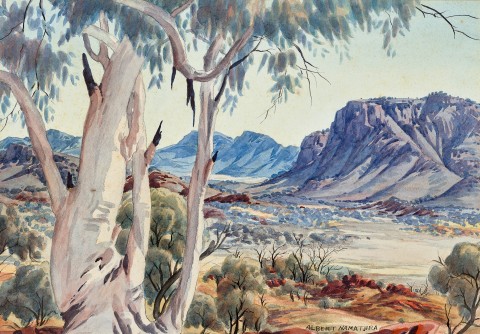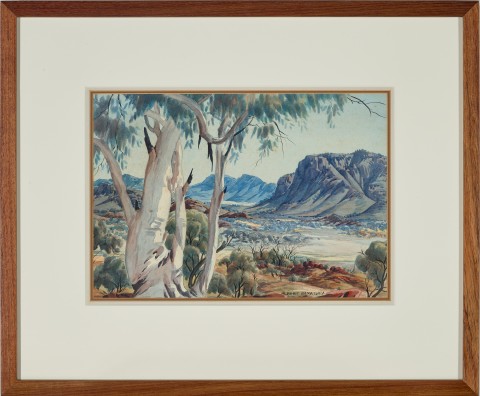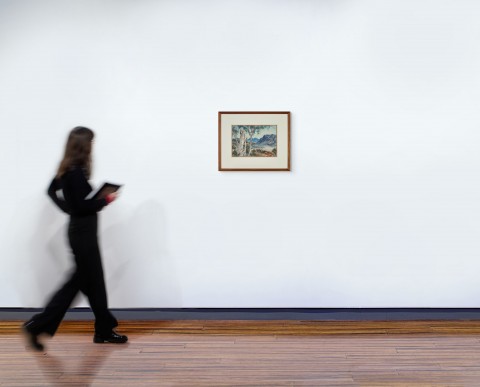NORTH GULLY LOOKING TO MT GILLEN, ALICE SPRINGS, c.1958
ALBERT NAMATJIRA
watercolour and pencil on paper on card
26.5 x 37.5 cm (sheet)
signed lower right: ALBERT NAMATJIRA
inscribed with title verso: NTH GULLY LOOKING TO MT. GILLEN, ALICE SPRING [sic.]
Private collection, Sydney
Private collection, Queensland, acquired c.1980
Thence by descent
Private collection, Queensland
Alice Springs Country, c.1955 – 59, watercolour on paper, 37.5 x 53.0 cm, illus. in French, A. (ed.) Seeing the Centre; The Art of Albert Namatjira 1902 – 1959, National Gallery of Australia, Canberra, 2002, p. 143
‘Albert Namatjira…emerges…as an artist of genuine creativity, whose work embodied the love of, and identification with the land.’1
In transporting his evocative landscapes of Central Australia into the lounge rooms of White Australia in the mid-twentieth century, Albert Namatjira set the foundations for the recognition of an Indigenous art that was to emerge thirty years later and flourish into the twenty-first century. A household name by the 1950s, and the first Aboriginal person to be granted full Australian citizenship, his depictions of country were fundamental to how Australians viewed their island home. ‘Namatjira's dramatic entry into the Australian art world was both inspired and inspiring. He inspired his own and subsequent generations of Aboriginal people and artists across Australia. In skillfully adopting the methods and materials of Western landscape painting he challenged the relegation of Aboriginal art to the realm of archaeology and ethnography.’2
Painted in the final years of the artist’s life, and typical of Namatjira’s later works, North Gully Looking to Mt Gillen, Alice Springs, c. 1955 – 57 is an exemplar of the artist’s recurring motifs. Located in the foreground, a majestic ghost gum (Eucalyptus papuana) – known as ilwempe to the Western Arrernte – frames the view to the abrupt slopes of Akngwelye (Mount Gillen) in the middle distance and out to the distant peaks beyond. ‘Namatjira’s familiarity with this country is evident in these views where trees, peaks and monoliths provide a rich range of possibilities and responses that arise from constantly re-engaging with the same subject.’3
One of three prominent hills surrounding Mparntwe (Alice Springs) and sacred to the Arrernte, Akngwelye (Mount Gillen) is found approximately ten kilometres to the west of Alice Springs rising up from the Larapinta valley. In Mythological times, Mount Gillen was the site of a struggle between an ancestral wild dog named Akngwelye and an intruder. Their skirmish created many of the natural features of the landscape to the west of Alice Springs and the striking peak of Mount Gillen is the resting place of Akngwelye. Wenten Rubuntja, artist and Chairman of the Aboriginal Areas Protection Authority in Mparntwe, explained the sensitivity to plural meanings required in the appreciation of Namatjira’s artworks: ‘…we’re not photographers, taking pictures. The country has got sacred sites, that stone, that mountain has got Dreaming and himself is sacred country. Not just free mountain. We sing that one – we got that song. Well, the song is the history of the country. […] Albert Namatjira used whitefella’s side of the story – he painted landscape. He painted the Twerrenge (Dreaming) side there as well. Namatjira used two Laws.’4
1. Nuggett Coombs, H. C., ‘Introduction’ in Amadio, N., Albert Namatjira; The Life and Work of an Australian Painter, McMillan, Melbourne, 1986, p. vii
2. Watson, K., ‘Poetic Justice: an overview of Indigenous Art’, in Perkins, H., One Sun, One Moon: Aboriginal Art in Australia, Art Gallery of New South Wales, Sydney, 2007, p. 20
3. French, A., Seeing the Centre: The Art of Albert Namatjira 1902 – 1959, National Gallery of Australia, Canberra, 2002, p. 96
4. Rubuntja cited in French, A., ‘We’ve Got to Follow that Old Man’s Tracks: Engaging with the Art of Albert Namatjira’, in Perkins, op. cit., p. 159
CRISPIN GUTTERIDGE


